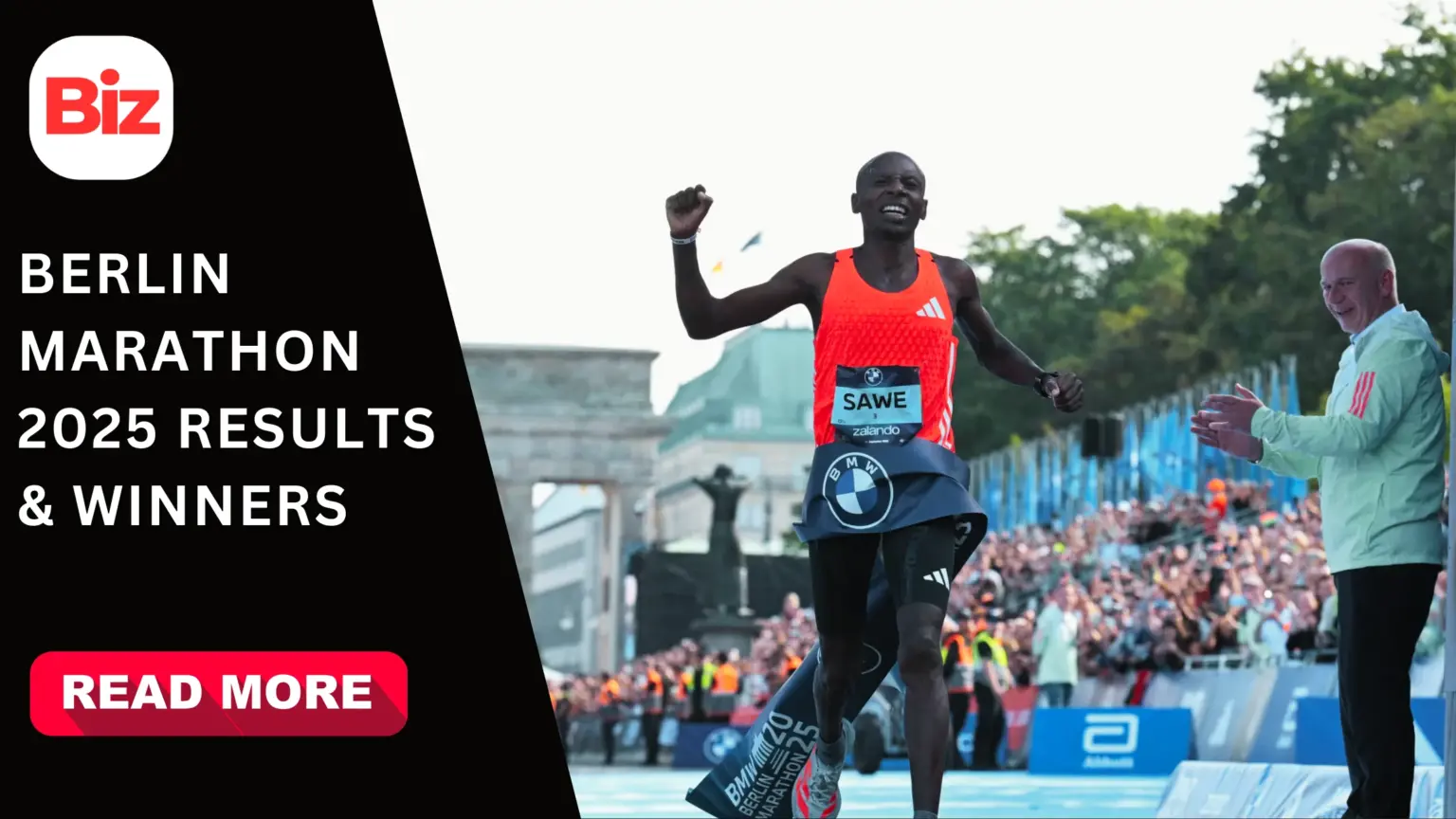Berlin Marathon 2025 delivered a compact, fast, and fiercely contested edition of one of the world’s benchmark city marathons. The 51st BMW BERLIN-MARATHON staged elite tactics, tight finishes, and strong community energy across a single weekend. Sabastian Sawe won the men’s race in 2:02:16 and Rosemary Wanjiru took the women’s title in 2:21:05.
Berlin’s course remains a magnet for speed. Its flat layout and wide avenues encourage even pacing and decisive moves. Still, the weather changed the equation. Temperatures climbed to around 25°C late in the day, which made the elite times feel even more impressive.
Men’s Race: Patience and Precision
The men’s competition emphasized patience and timing. Sawe conserved energy in the opening kilometers. He accelerated in the second half and kept a gap to the chasers. Akira Akasaki and Chimdessa Debele ran strong races, but they could not close the decisive move. The men’s top five reflected depth and strategic racing.
The women’s race unfolded more tightly. Wanjiru and Dera Dida matched each other stride for stride through the later stages. Wanjiru produced a decisive finish, crossing the line just three seconds ahead. That margin underlined how small differences determine victory in Berlin.
Festival Atmosphere in Berlin
Beyond the elite battles, the weekend is a city festival. Organizers expected roughly 80,000 participants across races and divisions. Inlineskating, a 5K, handbike events, and the marathon itself filled the program. Around one million spectators lined parts of the route and created a sustained roar for every runner.
Brands and event partners amplified the spectacle. BMW debuted the new iX3 as the official lead vehicle. The car appeared at the front of the field and underscored the event’s mobility and sustainability narrative. In addition, about 550 BMW Group employees ran the full distance, showing corporate engagement beyond sponsorship.
Event Logistics and Support
Logistics ran on long experience. The Marathon Expo at Messe Berlin handled bib pickup, partner booths, and last-minute needs. Medical teams and course marshals worked in concert with volunteers to keep the race safe and efficient. Those operational elements are invisible on race day, but they shape runner experiences profoundly.
Official timing produced detailed data for athletes and coaches. Split charts, net times, and category standings appeared quickly on the timing platform. Analysts will mine those Berlin Marathon results for pacing trends and tactical insights. Coaches can use the numbers to refine off-season blocks and race plans.
Road to the Berlin Marathon 2026 Lottery
If you are chasing an entry for next year, understand the options. The principal path remains the public draw. The Berlin Marathon 2026 lottery typically opens in October or November and runs about a month. To enter the Berlin Marathon 2026 lottery, you submit a registration on the official site and await the December draw. If the lottery does not favor you, charity places and approved tour-operator packages offer guaranteed spots.
Charity and qualification schemes run alongside the draw. The charity bibs require fundraising commitments and often secure guaranteed entry for dedicated runners. The program raises substantial sums; recent editions generated around five million euros for partner causes. Runners who qualify by age-group standards can also register via “Good For Age” slots, provided they meet published times.
National and International Highlights
German athletes produced notable national performances. Hendrik Pfeiffer led the German men in 2:09:14. Fabienne Königstein set the fastest German female time at 2:22:17. Wheelchair and handbike divisions featured elite winners as well, with Marcel Hug and Manuela Schär among top finishers in their classes. These results underline the event’s breadth across categories.
Tactical takeaways from Berlin are straightforward. On a flat course, even pacing often trumps early aggression. Sawe’s race demonstrated how measured speed and a well-timed surge can decide the outcome. In the women’s field, positioning in the closing stages and finishing speed mattered most. Athletes and coaches will translate these lessons into training cycles and race strategies.
Community, Media, and Legacy
Sustainability and community remained visible themes. Organizers promoted inclusion through wheelchair, handbike, and youth events. Corporate partners emphasized environmental and mobility messaging in their activations. The combination of performance, participation, and social impact makes the marathon more than a single race.
Media coverage captured both detail and drama. Specialist outlets provided split analysis and top-25 lists. Broader outlets conveyed headline narratives quickly to global audiences. For any reader who missed live coverage, the full Berlin Marathon results and timing archives remain accessible on official pages. Those pages include intermediate splits and complete standings.
Lessons for Runners and Coaches
Race-day atmosphere blended elite focus with amateur ambition. Fans kept the streets lively with music, banners, and local clubs. Berlin Marathon 2025 again proved the city’s appetite for running and community spectacle. The supporting program featured legends, music stages, and community events that extended the weekend beyond a single start and finish. For many runners, those human elements matter as much as the timing chip.
The finish lists underlined the international makeup of the race. Elite top-25 lists included athletes from Kenya, Ethiopia, Japan, and a strong European contingent. Analysts flagged the Japanese contingent’s depth in the men’s top ten. The Germans also performed well inside the leading ranks, reflecting domestic investment in distance running. The full top-25 sheets show how competitive the field has become and why Berlin continues to attract world-class entrants.
From a technical standpoint, Berlin remains prized because it distills a few essentials: flat terrain, efficient city logistics, and a crowd that fuels late-race efforts. Yet, the 2025 race also proved that conditions can complicate even the fastest courses. Hydration plans, cooling strategies, and realistic pacing remain central to achieving peak performance in Berlin. Coaches will pore over the intermediate splits to identify where races broke open and who managed their energy best.
Preparing for Future Races
For athletes and coaches plotting the season, Berlin’s fast times will shape planning for the 2026 cycle. Teams will weigh the benefits of Berlin’s course against other major marathons. Some athletes may prefer autumn targets, while others move to spring races. Managers and agents will talk tactics, recovery, and shoe strategy in the weeks ahead.
For recreational runners, the event underlines a clear truth: preparation and planning win. Build weekly volume slowly. Include quality tempo sessions and long runs that mimic late-race fatigue. Practice nutrition and cooling strategies in similar temperatures. Then, choose the right entry path — lottery, charity, or tour operator — well in advance.
Practical advice for prospective entrants is simple. Book travel and accommodation early. Prepare with conservative pacing and heat-adaptive workouts if you plan a fast time. Explore charity routes and tour-operator packages if you want guaranteed entry. And sign up for the draw when registration opens. The official website and partner pages publish exact dates and rules.
Conclusion
Berlin’s 2025 weekend again proved that fast times and festival energy can coexist. Runners at every level found reasons to celebrate. Looking back, Berlin Marathon 2025 offered clear lessons for pacing and race planning. Elite athletes left Berlin with benchmark performances and narrow, tactical victories. Community volunteers and hosts created the atmosphere that made those performances possible.
In short, Berlin combined speed, structure, and spectacle. If you hope to line up next autumn, plan early and follow official guidance. The city has shown that it still rewards careful pacing, bold moves, and committed preparation. The 51st edition will stand in many training plans as a useful reference for what elite and club athletes can aim to achieve.
Mark your calendar and prepare methodically; Berlin offers both a fast course and a festival atmosphere that rewards smart runners and careful planning. Start training right away.
Recommended For You
London Marathon 2026: Dates, Ballot, and What to Expect from the TCS London Marathon








